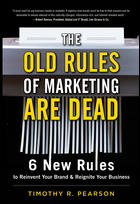 |
The complete title of this book is: The Old Rules of Marketing Are Dead – 6 New Rules to Reinvent Your Brand & Reignite Your Business, and it’s written by Timothy R. Pearson. Mr. Pearson is the former Vice Chair, Global Managing Partner, Marketing and Communications (and first Chief Marketing Officer) for KPMG, along with numerous other positions in management consulting, boards and societies. It’s from the perspective that he gained in the position at KPMG that much of the book is written, so it is understandable that the viewpoint is primarily about large corporations.
That’s not to say that there is nothing in this book for the small business – you simply need to adjust the language to meet your situation. For example, when the book refers to your marketing team, for the small business person that probably just means “you” – the same as your accounting team, management team, sales team, and back office operations team.
Mr. Pearson does a good job of walking us through the new paradigm in marketing that has come about in our post-Great Recession world… a world where Google, Facebook, Twitter, and blogs are the fastest growing communications media, replacing “old school” physical newspapers, magazines and television as we know it. Adding context to the discussion are events such as the BP Deep Horizon oil spill of 2010 and the events that led up to the Great Recession of 2008-2009.
Pearson uses these historic events to provide examples of how businesses like Goldman Sachs might have reacted differently from the standpoint of effective communications (obviously a huge part of marketing) and could have changed the outcome for the company. He then uses that information to explain how, to succeed in today’s world, businesses must reinvent themselves using fundamental structures and new technologies.
Foremost, this book can serve as a primer for anyone that needs to organize the activity of marketing in literally any size of business. The book takes the reader through concepts such as understanding the core of the business, developing a foundation for your marketing and communications, utilizing technology to communicate effectively with your customer, and providing leadership in the effort (as appropriate).
I think Pearson explains these concepts in a manner such that anyone can use this book as a place to start on the process to understand, develop, and put into action a marketing strategy to reinvent your particular brand.
One point where I felt like the author seemed to be slightly out of touch was in his listing of advancing social media, where not once but twice he includes MySpace in his list. I don’t think it’s a damning issue, especially since he acknowledges Facebook and Twitter first, but listing MySpace and not including the likes of FourSquare and Yelp as advancing and dominating social media does seem a bit odd.
All in all, I found this book to be a very good overview of the sorts of issues that the modern-day marketing professional faces (even if the marketing professional is a sole proprietor). Pearson’s experience and know-how in the world of marketing is communicated in an easy to understand manner. The principles presented are put into recent context (BP oil spill, Great Recession, etc.) so that the reader can relate to the principle easily. It’s a good book and I would recommend it to anyone with marketing as a task.
The above book review is part of a series of reviews that I am doing in an arrangement with McGraw-Hill Professional Publishing, where MH sends me books with the only requirement being that I read the book and write a review – like it or not. If you find the information in this review useful, let me (and McGraw-Hill) know!


 Sterling Raskie, MSFS, CFP®, ChFC®
Sterling Raskie, MSFS, CFP®, ChFC® The latest in our Owner’s Manual series, A 401(k) Owner’s Manual, was published in January 2020 and is available on
The latest in our Owner’s Manual series, A 401(k) Owner’s Manual, was published in January 2020 and is available on  A Medicare Owner’s Manual, is updated with 2020 facts and figures. This manual is available on
A Medicare Owner’s Manual, is updated with 2020 facts and figures. This manual is available on  Social Security for the Suddenly Single can be found on Amazon at
Social Security for the Suddenly Single can be found on Amazon at  Sterling’s first book, Lose Weight Save Money, can be
Sterling’s first book, Lose Weight Save Money, can be  An IRA Owner’s Manual, 2nd Edition is available for purchase on Amazon. Click the link to choose the
An IRA Owner’s Manual, 2nd Edition is available for purchase on Amazon. Click the link to choose the  Jim’s book – A Social Security Owner’s Manual, is now available on Amazon. Click this link for the
Jim’s book – A Social Security Owner’s Manual, is now available on Amazon. Click this link for the  And if you’ve come here to learn about queuing waterfowl, I apologize for the confusion. You may want to discuss your question with Lester, my loyal watchduck and self-proclaimed “advisor’s advisor”.
And if you’ve come here to learn about queuing waterfowl, I apologize for the confusion. You may want to discuss your question with Lester, my loyal watchduck and self-proclaimed “advisor’s advisor”.